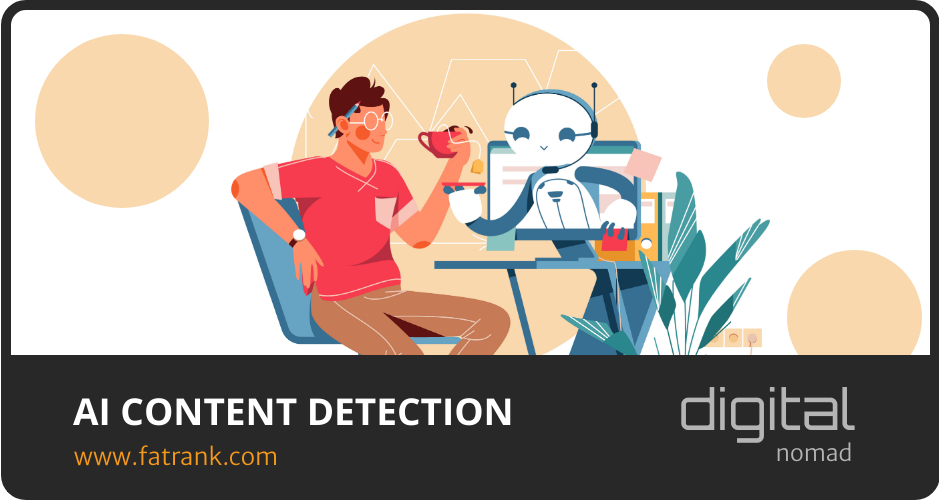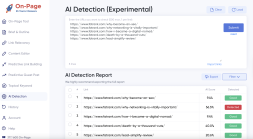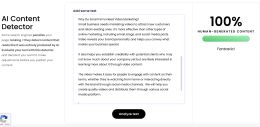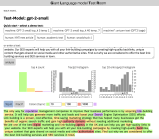
AI Content Detection
Many freelance content writers have started to write blog posts using AI content writing tools in April 2025.
When paid by SEO agencies to write quality, unique content, copywriters or writers should not be using GPT-2, GPT-3 tools, GPT3.5 or ChatGPT.
GPT4 by OpenAI is just around the corner, and LLM (large language models) like GPT3.5 can replace many text generations.
But, the point of this article is that if you are paying for human-written unique content, you should not be getting AI-generated content back.
Our AI Content Detection guide explains everything you need to know about detecting AI-generated content.
Contents
Why is it important to detect AI content?
Organizations, government agencies, and universities have a strong interest in determining if a piece of content was generated using a language model or AI text tool.
What percentage of the thesis handed is authentic, written by a human?
With the advancements of ChatGPT and GPT4, the text generated by these tools is nothing short of amazing.
It is important to have the watermarking detection in place, or students/employees could be using these tools and passing them off as their own.
Marketers and SEO companies who buy content may want to understand the extent to which the content they have acquired was generated using tools such as GPT3 or Jasper, Writesonic, or copy.ai.
Can Google Detect AI Content?
It is unclear whether Google can truly detect AI content automatically. However, we know that Google deems AI content spammy when reviewed manually.
Despite this, many AI content detectors do this job pretty accurately, leading many to believe that Google has implemented similar technology to its algorithm.
As there is no proof of this, it’s difficult to definitively say whether Google can detect AI content automatically or not.
How to Detect AI-Generated Content?
The best way to detect AI-generated content is to use an AI content detector tool online.
These tools are the best way to return accurate data on which articles have been written by artificial intelligence, which can be great when checking content written for you.
Ensuring your content has not been written by AI is important, as your chances of ranking with AI content are worse off than if it’s an original article, particularly if that AI content is taken directly from your competitor’s website.
How can we detect AI content as written with GPT3 or ChatGPT?
Here are some methods on how to detect whether GPT3 or ChatGPT has written content:
- Check for linguistic features or patterns that are common in machine-generated text. e.g. AI-generated text might have higher levels of repetitiveness or lack the complexity and variability of human-written text.
- Checking for specific formatting or structural features that are common in machine-generated text. e.g. AI-generated text might have a more uniform structure or lack the variety of formatting typical in human-written text. They sometimes look “too good to be true”.
- Checking for certain keywords or phrases that are commonly used in AI-generated text. That’s a lot harder already. In general, statistically significant patterns are known and detectable of which word combinations a model like GPT3 picks.
- Comparing the content in question to known examples of machine-generated text. This could be done manually or especially using machine learning techniques to analyze the content and determine its likelihood of being generated by a machine again.
The detection methods above were taken from What Percent of Content is Real and How to Find Using AI Watermarks.
Best AI Content Detectors
Here are the best AI content detectors in April 2025.
On-Page.ai
The on-page-ai content optimisation tool has an amazing feature to detect AI-written content.
We love how quick and easy it is to load in your URLs in bulk to check the uniqueness of articles, and it’s a great way to monitor new or existing content.

It’s worth mentioning that, as with any AI content detector, sometimes the tool can say an article is written by AI, when it isn’t.
This is particularly true of more informative articles, where there are only so many variations to how they can be written.
Overall though, the On-Page.ai AI detection tool is one of the most accurate.
Writer.com
Writer.com also does a tremendous job with its AI detection, which is another tool worth looking at.
Whilst bulk URLs can not be submitted here, its detection software is still very accurate and easy to use.

Simply add the content, and let the tool do all the hard work for you.
Here is a great link to load content and test whether it is listed as AI-generated content – https://writer.com/ai-content-detector/
In Christoph C. Cemper tests on “AI Content Detector by Writer” it provided false positives and the AI detection tool was NOT accurate
Hugging Face
Hugging face is another of the better AI detection tools, with accurate and reliable data returned from its site.
Again, similar to writer.co, Hugging Face uses a “copy and paste” system to detect AI content, currently with no option to be able to submit URLs to be analysed.

Despite this, this tool is still super quick and easy to use and does a good job when it comes to AI detection for content.
Check out the AI detection software here – https://huggingface.co/openai-detector/
In Christoph C. Cemper tests on “OpenAI GPT2 Content Detector on Huggingface” it failed miserably. Plus why promote an AI detection tool that only runs on GPT2 when the latest LLM (large language models) like ChatGPT and GPT4 are the newest technologies it needs to be detecting
GLTR
And finally, there’s GLTR.
This AI content detection tool, an abbreviation of “Giant Language model Test Room”, is again one of the better AI detection tools out there, and one of the 4 out there we’d recommend using.

To use GLTR, simply copy and paste your content into the box on their site, and let their detections software get to work.
Check out http://gltr.io/dist/ today.
In Christoph C. Cemper tests on “AI Detection with GLTR – Giant Language model Test Room” again GLTR detections are on GPT2 and with the new ChatGPT which generates a much richer, much more interesting text result, it also looks more human to a GPT2-based detection tool. So Giant Language model Test Room detection failed on its results
Content At Scale
AI Detection with ContentAtScale has a free AI content detector to see if your content shows as being produced by AI.
AI Detection with Content At Scale is marketed to check for ChatGPT, GPT-3, and other AI models.
Check out https://contentatscale.ai/ai-content-detector/ today.
In Christoph C. Cemper tests on ContentAtScale free AI content detector it failed on detecting content produced by ChatGPT and returned to be 100% human written
Originality.ai
Originality.AI’s AI detection module provides a score from 0-100 on the chance that the content scanned was produced by an AI writer.
AI Detection with Originality.ai is available here https://originality.ai/
In Christoph C. Cemper tests on it returned the best results on AI Detection (but still was not perfect and provided false positives)
OpenAI Detector
OpenAI detector is a free-to-use public AI content detector initially created for GPT2 AI content.
They have created a straightforward tool that now does a respectable job of recognising GPT3.
GPTZero
GPTZero is a cutting-edge AI detector that was created to stopChatGPT.
It tracks AI models and finds their digital fingerprints using sophisticated features.
They are now creating technologies for teachers to prevent students from using AI for high school and college exams.
Copyscape
Copyscape is one of the easiest plagiarism checkers to use.
It is a well-known tool that many people and businesses use to ensure that written content is original.
It compares the informationto a massive database of web pages and other publicly available content to see if there are any instances of duplicate content.
Copyscape has an easy-to-use interface and makes detailed reports that list any duplicate content found. Copyscape is a great and reliable way to check for plagiarism and is used in many fields and situations.
Advantages of AI Written Content
With AI-written content, there are several advantages over having content written by humans. These include:
- saves time
- saves money
- works with location-specific language
- generates new content writing ideas
- AI technology is getting more and more accurate.
These are some of the many reasons why many SEOs and digital marketers are looking more into AI-written content than ever in 2025.
Disadvantages of AI Written Content
Despite this, several disadvantages to AI written content are worth considering. These include:
- AI content can be inaccurate
- AI content can be out-dated
- AI content can read poorly
- It’s difficult to break the SERP with AI content
- Google disapproves of this content type
Considering these disadvantages before solely relying on AI content can save you from making mistakes that may come to haunt you in the future.
Our advice would be to look into using AI content where you can, but for money site content that requires specialist knowledge of a subject, we’d always recommend writing the content yourself or by a trusted writer.
FAQs
Are AI Writers Worth It?
AI writers are worth it for those wanting to bulk-write content without the time and cost of a traditional writer.
Despite this, AI content often lacks the quality and relevancy of a human-written article, which is something to consider.
How Does AI Work?
AI works by collecting large pools of data about a certain topic or set of topics and automatically learning the patterns and behaviours of that data through their algorithms.
In the case of content writing, your chosen topic will be analysed to create automated content based on the AI’s understanding of your SERP.
What Are The 3 Key Elements Of AI?
The 3 key elements of AI are machine learning, deep learning and neural networks.
Each of these elements is fundamental regarding how AI operates successfully.
Summary
So to summarise, AI-written content is becoming more and more popular within the marketing, SEO and online industries, and as a technology, is improving by the day.
With a better choice than ever of easy-to-use, reliable AI content writing tools, there’s never been a better time to test out having written content by artificial intelligence.
Overall, this content writing technique can save you a fair bit of time and energy, but weighing up the quality and accuracy of the content in relation to what a traditional content writer can achieve will measure how useful AI content can be for you.
If you are thinking of using AI writing software you might want to check out our saying, “it is only a problem when it is a problem – and then it is too late”.

About FatRank
Our aim to explain and educate from a basic level to an advanced on SEO and Social Media Marketing.
